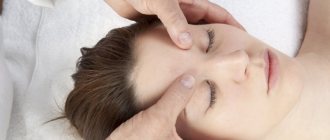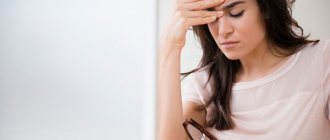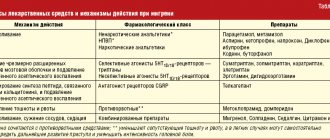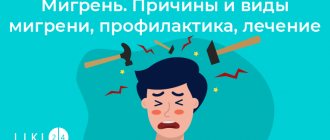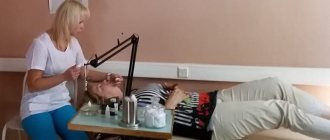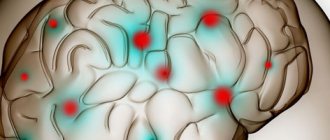Useful articles
Many people mistakenly believe that migraine is a disease of adults, but as practice shows, it occurs among children and adolescents. The difficulty lies in the fact that it can be quite difficult to diagnose migraine in adolescents in a timely manner and, accordingly, treat it adequately. In reality, this disease greatly worsens the child’s quality of life and causes him constant discomfort, both physical and psychological.
Causes
During adolescence, migraines can develop as a result of the following factors:
- lack of sleep;
- hormonal imbalance;
- menarche in girls;
- music too loud;
- overwork of the body, both physical and mental;
- stress;
- acclimatization to new conditions;
- spending long periods of time in front of a computer monitor;
- very bright light;
- poor nutrition;
- smoking;
- drinking alcohol;
- taking certain medications;
- long journey.
NEW LEVEL
According to the international classification, colic is repeated attacks of screaming, crying, and anxiety . Episodes last 3 or more hours per day, 3 or more days per week, for 3 or more weeks. Colic peaks at 6-8 weeks of age and usually resolves by 4 months of age. The prevalence of colic ranges from 5% to 19%.
Mentions that infant colic may be associated not with gastrointestinal disorders, but with headaches, began to appear in articles and translated books somewhere in the mid-90s. Despite the fact that well-known, respected authors wrote about this, it was very difficult to accept and understand this point of view. Colic is when the tummy hurts: a well-known fact. But most importantly, parents see with their own eyes the symptoms that accompany prolonged child crying, and they are somehow not similar to the manifestations of migraine. Of course, no one expects a newborn to complain of a headache, but a tense, swollen belly, tucked legs, the magical effect of the gas tube during periodic evening crying are obvious things that in no way correlate with the symptoms of migraine... But there is more and more evidence that infant colic - This is one of the types of headaches (migraines).
The results of a new meta-analysis examining the relationship between colic and migraine suggest that colic is an “age-specific migraine phenotype.” According to lead researcher Amy Gelfand, assistant professor of clinical neurology and pediatrics and pediatric neurologist at the University of San Francisco Headache Center, it's time to put an end to the oft-repeated theory that colic has something to do with feeding and gastrointestinal problems. Dr. Gelfand is convinced that the time has come to add colic to the core list of the International Classification of Headache Disorders (ICHD). The condition is now classified as an "episodic syndrome that may be associated with migraine."
In adults, experts note the following factors that provoke migraines:
1. Psychotraumatic situations that can easily cause instability of vascular tone;
2. Drinking alcohol, especially red wine, excessive addiction to coffee, tea, Coca-Cola;
3. Sleep disturbance, both lack and excess;
4. Ignoring diet, since migraine requires dieting. Probably no disease has such a wide range of foods that can cause exacerbation as migraine. At the same time, this set is different for each sick person. There is cheese, nuts, chocolate, citrus fruits, bananas, chicken liver, sausages, and even yoghurt. In addition, hemicrania needs to be “fed” on time and regularly, since it absolutely “does not like” hunger and snacking “on the go”;
5. Physiological hormonal changes, as well as changes caused by taking oral contraceptives or estrogens as replacement therapy;
6. Physical activity and fatigue;
7. Changes in weather conditions, cold;
8. Bright or flickering light, noise or loud sounds, being at heights;
9. Smells (perfumes).
How does this relate to the causes of infant colic? Maybe the air, sounds, smells, and rhythms of life in the modern world bombard an unprepared little person in a volume that exceeds his ability to adapt? Can you imagine the evening well-being of a young lady of the Turgenev type, abandoned for a day from a shady estate on the side of a busy highway? It is possible that migraines in children begin from a discrepancy between the actual load on their senses and the one for which they are designed by nature...
And scientists are making more and more discoveries linking infant colic and migraines. For example, a study presented last year at the American Academy of Neurology found that women who had migraines reported colic in their babies about twice as often as those who did not suffer from migraines. (Migraines can run in families.)
Another not-so-good news is that when a colicky newborn grows up, he or she is at risk for developing migraines and other types of chronic headaches. A study recently published in one of the most widely read publications in the world, the Journal of the American Medical Association, found that having colic in babies is approximately seven times more likely to cause colic. migraines in older age. Luigi Titomanlio, head of a pediatric clinic in Paris specializing in the treatment of neurovascular diseases and migraines, and his colleagues analyzed information on children who were diagnosed with migraine after attending emergency hospitals between April and June 2012. The control group was children who visited the ER for other reasons during the same period. The researchers asked parents about their babies' colic symptoms in infancy and looked at medical records from the newborn period. About a thousand children aged 6 to 18 years participated in the experiment. It turned out that almost 73% of children who suffered from migraines also, according to their medical records, suffered from colic in infancy. Of those children who did not suffer from headaches, only 26% experienced colic in infancy. In general, the experiment showed that the chances of experiencing chronic headaches among those who suffered from colic were 6.6 times higher than among those whose parents did not complain about colic in their child.
Dr. Phyllis Zee, professor of neurology and director of the Sleep Disorders Center at the Feinberg School of Medicine at Northwestern University in Chicago, recommends that parents avoid bright light at bedtime. baby, and loud noises, such as from the TV . The normal process of falling asleep is very important to prevent migraines and, consequently, colic. She strongly recommends getting enough light during the day and going to bed in the dark.
Dr. Zee also calls accumulating lack of sleep one of the causes of migraines in infants. Hormonal imbalances are considered one of the common triggers for migraines. Sleep cycles may play a role in the disorder, along with disruption of the production of melatonin, a hormone that induces sleep and regulates the body's internal clock. While most melatonin is produced in the brain, some of it, Dr. Zee explains, is produced by cells in the digestive tract. The release of melatonin in the digestive system can affect intestinal motility, which may cause some colic symptoms. Disturbances in circadian sleep rhythm can be obvious triggers for colic and migraines, and parents can take steps to change these factors without medication, she said.
What exactly, without the use of drugs, will help reduce the likelihood of colic in a child:
— Choose a maternity hospital where the staff avoids unnecessary intervention in childbirth, including medication. Before you decide to have an epidural, read as much as you can about the procedure so you can weigh the pros and cons in an informed manner.
— If you had a quick labor, a difficult prolonged or too painful labor, if the baby was born with a cephalohematoma, bruises on the face and head, show the baby to an osteopathic doctor as soon as possible.
— Provide your newborn with optimal sleep conditions. The optimal ones are not elegant textiles for the crib or even an orthopedic mattress. It is necessary to organize the child’s sleep in such a way that he wakes up only when he has slept and rested, and not a minute after trying to put him in the crib and tiptoe away. Is this possible only if the mother holds the sleeping baby in her arms or lies down next to her? It's great that there is such an opportunity! Be sure to use it.
— Not too much light at night. Try to ensure your baby gets as much light as possible during the day. In the evening, create twilight, turn off the TV and any sources of loud sounds. A disruption in natural circadian rhythms causes hormonal imbalances in newborns, which also provoke migraine attacks.
- Feed your baby on demand. Sharp, and even more so, prolonged changes in blood glucose levels cause more frequent attacks.
— Avoid any extreme exercises and hardening procedures. The stress that occurs under such loads, perhaps, hardens the child for future life difficulties, but at the same time it creates the ground for periodic spasms of the blood vessels of the head and intestines, and parents experience difficulties not in the vague future, but here and now.
Tatyana Kondrashova for “New Level”
Photo of Natalia Nechaeva was used in the design of the article
Go to other interesting articles on breastfeeding for mothers
Our useful and interesting webinars for nursing mothers
Migraine symptoms in teenagers
Migraines are often observed in those children who are determined, ambitious, and have an active lifestyle. Signs of migraine in a teenager that requires immediate treatment may include:
- splitting pain in the head, which can be localized in the temples, frontal lobe, eyes, one half of the skull;
- lack of strength;
- nausea;
- general weakness in the body;
- vomit.
The duration of the attack varies: from one hour to several days, which is why the teenager’s well-being suffers greatly. During periods of pain, the child takes his head with his hands and bends away from it. Usually, for migraines, simple analgesics do not give the expected effect.
Helping your baby before and after birth
What can you do to protect your baby from the suffering associated with colic?
— The most important thing you should take care of is to find an opportunity to learn how to properly care for your baby and establish adequate breastfeeding. This is especially true if your birth was not very successful and the baby’s health has already suffered. Maternal professionalism will help cope with the painful conditions of the baby and reduce them to a minimum.
- Keep in mind that dill water and other “tummy tummy” remedies will not help a child with colic. On the contrary, they can only worsen your child's condition by disturbing the natural balance in his digestive system. After all, the gastrointestinal tract of a newborn is designed only for mother’s milk, and all foreign products injure it and lead to a variety of disorders in addition to existing problems.
— On the issue of complementary foods: the baby is first ready to receive foreign foods only at six months. Therefore, full breastfeeding is especially important for a child suffering from colic - this will save him from unnecessary stomach suffering. But most importantly, mother’s milk contributes to the normal development and even restoration of the baby’s nervous system. That is why exclusive breastfeeding without supplementing or feeding the baby for up to six months, and frequent feeding to the breast is an excellent prevention of the notorious colic.
— And one more warning: do not use gas tubes or enemas! Unfortunately, many mothers, at the first sign of anxiety in their baby, resort to these favorite “helpers.” Be merciful to children! The opinion that these remedies bring relief to the baby is wrong. But the child quickly gets used to it, and without an enema he can no longer cope with problems. In addition, irritation of the anus begins to give pleasure to many, but this does not lead to anything good.
— Be careful with baby yoga, dynamic gymnastics and diving. Rozhana specialists believe that this can lead to increased intracranial pressure, inconsolable crying and the appearance of foamy stools. In addition, children with whom we practice baby yoga often suffer from sleep disorders.
There are several types of migraine in teenagers:
- with ophthalmoplegia, when the functioning of the eye muscles is disrupted (dilated pupils, blepharoptosis);
- simple - manifested by sharp or increasing pain, intensifies with movement, accompanied by abdominal pain, muscle tension, the desire to hide from the light source, vomiting;
- basilar – characterized by speech and coordination disorders, vomiting, blurred vision, dizziness (usually occurs in girls during puberty);
- with aura - this is a migraine, in which typical signs first appear (flashes of light, spots before the eyes, sensation of smells), and after them, after 30-60 minutes, an attack of pain begins;
- with hemiparesis - this migraine is accompanied by impaired motor and speech functions, muscle weakness, clumsiness, and there may be a visual aura.
The pain will definitely pass
If, despite proper care and breastfeeding, colic still persists, you just need to wait. By three months, a child’s headaches associated with changes in atmospheric pressure and changes in the electromagnetic background disappear or, at least, become much less active. From now on, your baby will cry much less.
The child is finally free from headaches by six months. This happens almost always and without any special treatment.
Treatment of migraine in adolescents
This disease is quite difficult for adults, and even more so for children. It is important that parents are interested in the child’s treatment and are actively involved in the therapy process. This will help avoid such negative consequences of the disease for adolescents as: complexes, decreased performance and self-esteem, and self-isolation.
Important: Treatment of migraine in adolescents must begin at the first signs of the disease, and this should only be done under the supervision of a doctor! Specialists will not only select the necessary medications, but will also tell you in detail how to live with this disease, because it has a predominantly chronic course and requires patience and consistency in the activities carried out. During an attack, the child should take the prescribed pills, lie down, close the curtains in the room, open the window, apply a wet compress to the head or massage and try to sleep, since the migraine usually goes away after sleep. In your diet, you should limit the consumption of foods such as canned food, sausages, chocolate, sweets, etc., replacing them with fresh vegetables, fruits, lean meat and fish, milk, kefir, and yogurt. In some cases, acupuncture and working with a psychotherapist have a good effect. It is not uncommon for migraines to go away on their own after age 20, but this is not always the case. You need to learn to live with it and behave correctly during attacks in order to almost completely neutralize their impact on your general condition. The doctors at Alkoklinika will certainly help you with this.
The text was checked by expert doctors: Head of the socio-psychological service of the Alkoklinik MC, psychologist Yu.P. Baranova, L.A. Serova, a psychiatrist-narcologist.
CAN'T FIND THE ANSWER?
Consult a specialist
Or call: +7 (495) 798-30-80
Call! We work around the clock!
How to make an appointment with a neurologist
If you are looking for a neurologist in the center of Moscow, then you should contact JSC Meditsina (clinic of academician Roitberg). The staff consists of highly qualified professionals. Specialists quickly diagnose the disease and prescribe the most optimal treatment, taking into account the specifics of the symptoms, the age of the child, and the individual characteristics of the body.
Our clinic is located in the central district of the capital. We are located at the address: 2nd Tverskoy-Yamskaya lane, building 10 (Mayakovskaya metro station). You can contact us and make an appointment with a doctor using a special form posted on the website, as well as by telephone numbers (24-hour service).



